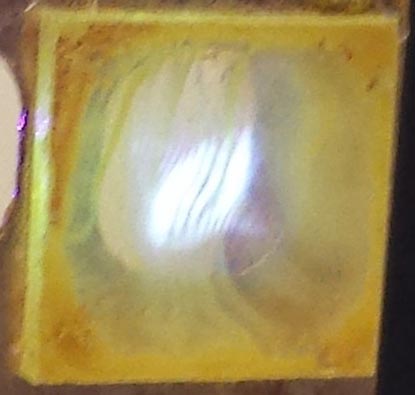R. Colin Johnson
EE Times
Today, white LEDs are not really white, but instead use techniques such as combining the light emission of separate red, blue, and green (R-G-B) LEDs, or coat blue LEDs with yellowish phosphors. Now, researchers at the University of Utah have found a way to tune the color of emission of a polymer semiconductor in hopes of creating organic light emitting diodes (OLEDs), which produce true white light.

The technique inserts platinum atoms inside the polymer interchain of an organic semiconductor, with different spacings allowing it to produce different colors of light. Their hope is to create a polymer with various spacings of platinum atoms, allowing them together to create white light from a single material.
 |
| Z. Valy Vardeny, University of Utah physicist, uses a glove box to handle light-emitting polymers under cleanroom conditions. SOURCE: University of Utah |
"We put the platinum atoms inside a polymer interchain using a synthetic process," said University of Utah Professor Z. Valy Vardeny in a telephone interview with EE Times. "And we change the spacing between the platinum atoms to tune the color emitted."
In addition, the platinum-rich polymers not only fluoresce, like R-G-B LEDs, but also phosphoresce like phosphor-coated LEDs, potentially making them much more energy efficient than traditional OLEDs.
"OLEDs today fluoresce, converting only about 25 percent of their energy into light, but our platinum-rich polymer is phosphorescent too, allowing us to recover come of the remaining 75 percent of electrical energy," said Vardeny.
The next step for the researchers is to experiment with different spacings between the platinum atoms in the polymer interchain, as well as to experiment with other heavy molecules besides platinum. To date, the researchers have produced two materials -- one with a platinum atoms between every link in the interchain -- resulting in violet and yellow light, the other inserted a platinum atom between every third link, resulting in blue and orange light. The hope is that a polymer with various spacings between platinum atoms can produce all the wavelengths in white light.
"The ultimate goal is to create white light. Unfortunately, white light is very not well defined, but essentially we want to emit all colors," said Vardeny.
The platinum-rich polymer today must be stimulated by light to work, but once the formula for a white-light polymer is defined, the researchers will fashion an OLED material out of it that emits in response to electrical stimulation. The researchers estimate about a year will be needed to perfect the white-light emitting polymer and another two to convert it into an OLED.
The researchers also plan to apply the technique to creating a new type of solar cell. And because platinum-rich polymers allow information to be stored on the spin of electrons, the material has the potential to create a new type of memory chip.